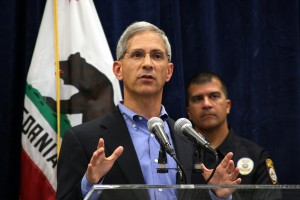
"These regulations expand insurance options for consumers, allowing a freer market to create incentives for driving less."
California has just completed hearings on a proposal to have insurance companies sell “pay as you drive” plans that will offer a greater spread in rates than currently. Potential big winners are those who drive relatively fewer miles, while people with long commutes could see an increase in rates.
The proposed state regulations, which could be in place by this fall, allow automobile insurance companies to offer the new plan in the country’s largest market, and one where uninsured drivers remain a problem.
The Brookings Institute has been suggesting usage-based insurance rates as a national policy as a way to get people to drive less, which means making it more expensive to drive. A trend appears to be emerging that has various government entities saying that increasing the cost of driving is a good way to reduce greenhouse gases. It is also, of course, a way to increase falling revenues, as actual miles driven are dropping as the Great Recession drags on, although this rarely stated in official announcements.
Under the California plan, companies can continue to offer traditional insurance based on estimated mileage. However, now they can also offer a verified mileage program instead of or in addition to a traditional estimated mileage program. The insurance industry has generally positive opinions about the program, particularly after cell phone type billing was added to the proposal.
“These regulations expand insurance options for consumers, allowing a freer market to create incentives for driving less,” said California Insurance Commissioner Steve Poizner. “By empowering consumers to take charge of their insurance bill, we may see fewer cars on the road; which means cleaner air, safer streets and lower premiums.”
Whether a usage-based plan actually results in lower premiums and not just a plethora of new marketing options that increase the profits of insurance companies and the fees the state earns remains to be seen.
The three mandatory rating factors, among many others, that are used in California to set rates are, first, the driver’s record; second, the number of miles driven; and, third, the number of years of experience.
One controversial part of the new plan is the mileage verification provisions. One would see transponders placed on cars to ensure that mileage based rates are accurate. Other ways to verify mileage include Motor Vehicle smog test records, and repair shop or insurance company readings. As in cell phones, rates could vary based on the number of miles bought, and rates could be changed retroactively if mileage limits are exceeded. Also, the amount charged for more miles could be higher after a mileage limit had been exceeded. This isn’t necessarily consumer friendly, as anyone who has wrestled with cell phone usage plans can tell you.
Steve Poizner was elected as California Insurance Commissioner in 2006, Poizner founded several technology companies. His last company, SnapTrack, pioneered GPS receivers into cell phones.
Pay as you drive is not a knew concept, GMAC has offered it to drivers with OnStar since miles driven can be easily verified though satellite monitoring. Called the “low-mileage discount,” currently OnStar subscribers in 34 states are eligible. Active OnStar subscribers simply sign up to save on their premiums if they drive less than 15,000 miles annually and get a 26% discount. Subscribers who drive even less than that can save even more, up to 54%.
The odometer reading from a monthly OnStar Vehicle Diagnostics email is forwarded to GMAC Insurance. Based on those readings, the company will adjust the premium using discount tiers corresponding to miles driven. The company is quick to add that data sent from OnStar to GMAC Insurance pertains solely to mileage, and no additional data is gathered or used for any purpose, the company says.
The Brookings study maintains that lump-sum pricing of auto insurance is inefficient and inequitable since drivers who are similar in other respects — age, gender, location, driving safety record — pay nearly the same premiums if they drive 5,000 or 50,000 miles a year.
“Just as an all-you-can-eat restaurant encourages more eating, all-can-drive insurance pricing encourages more driving. That means more accidents, congestion, carbon emissions, local pollution, and dependence on oil. This pricing system is inequitable because low- mileage drivers subsidize insurance costs for high-mileage drivers, and low-income people drive fewer miles on average,” according to the study.

